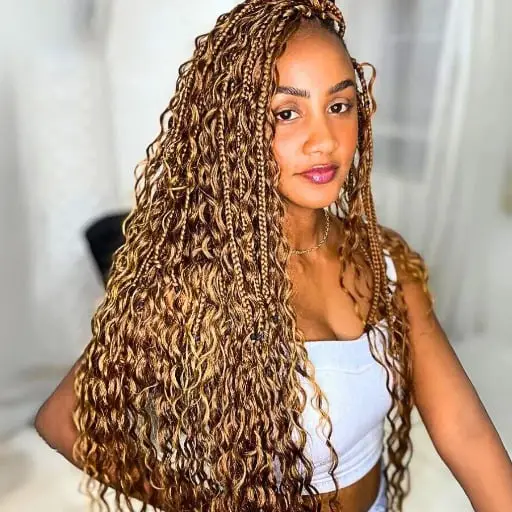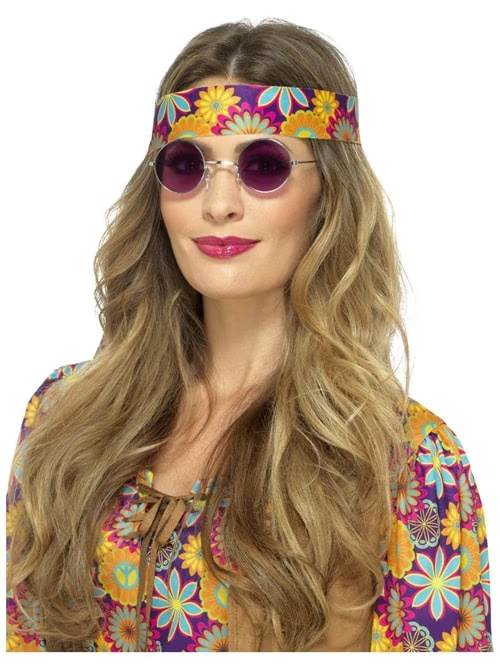What Are Hippie Braids Hairstyles?

“Hippie braids” is a casual term used for braided styles that carry a relaxed, bohemian or festival-inspired vibe. These styles often combine elements such as:
- small to medium sized braids mixed in with loose hair, sometimes wavy or textured
- braids that are not overly neat or rigid — a bit messy or undone is part of the look
- adornments like beads, cuffs, ribbons, or small wraps added to the braids
- hair left loose or partially pulled back (half-up) rather than tightly secured
The term overlaps with “boho braids” or “festival braids,” and while it’s less of a strict technical style than some braid names, it’s become popular for conveying a relaxed, creative hair look.
Table of Contents
Key Features of Hippie Braids Hairstyles & Why They Work
Here are some of the main characteristics and why they make these braids appealing:
Texture and loose styling
Rather than sleek, ultra-tight braids, hippie braids often embrace texture — think wavy hair, slight frizz, braids with hair gently pulled out (sometimes called “pancaking”) to widen the braid, and a less perfect finish. This adds to the casual charm of the look. (Stylish Life for Moms)
Mixed braid types
A full head of identical braids is certainly possible, but in hippie braid styling you’ll often see a mix: a few thin accent braids among loose hair, or a few braids pulled back with some hair left down. That variation adds interest. (STYLECRAZE)
Accessorised elements
Adding beads, hair rings, ribbons or small decorations to braids gives them that free-spirited flair. The adornments emphasise the style’s connection to boho or festival hair culture. (STYLECRAZE)
Versatility across hair lengths and textures
Although commonly seen on longer hair, hippie-braid styles can be adapted for medium or even shorter hair lengths. They also work on different hair textures: straight, wavy, curly. The key is adapting the braid width/placement and how much loose hair remains. (Stylish Life for Moms)
How to do hippie braids (at home)
Here are a few basic steps you can follow, and you can adjust depending on your hair length, texture and how elaborate you want the style to be.
- Prep the hair
If your hair is freshly washed and sleek, you might want to add some texture so the braids hold better and the look stays in place. A light texturising spray or sea-salt spray helps give grip and a relaxed finish. (STYLECRAZE) - Decide on braid placement
Choose how many braids you want, and where. A common choice: a few thin braids around the front (face-framing), or two small braids on either side with the rest left loose. For a half-up look, pull the top section and braid it, leaving the rest down. (Stylish Life for Moms) - Braid and loosen
Braid your sections (three-strand, fishtail, Dutch, etc) and once done you can gently pull the outer edges of each braid to widen it (the “pancaking” technique) to get a fuller, more relaxed look. (Stylish Life for Moms) - Add accessories
If desired, add beads, small metal or wooden rings, ribbons or even small flowers to the braids. This adds the boho/hippie flair. - Finish and loosen further
Once done, you might pull out a few wisps of hair around the face or loosen the braids a bit more to keep it from looking too tight or structured. A light mist of flexible hold hairspray can keep things in place without locking the look down.
Hippie Hair Do

Hippie Style Hairstyles
Hippie-style hairstyles draw inspiration from the 1960s and 70s counter-culture, while also incorporating modern adaptations. At their core they are relaxed, natural, free-spirit looks rather than ultra-precise or high-gloss. Common features include:
- Natural texture: waves, curls, frizz, or lightly tousled hair rather than super sleek polished hair.
- Middle parting or soft, low side parting supporting a casual silhouette.
- Accessories like headbands, scarves, beads, small braids, or loose wraps.
- Braids or plaits mixed in with loose hair (for instance a thin front braid or micro-braids through a section) or full loose braids.
- Colour or highlights that evoke sun-lit or nature-inspired tones (e.g., soft ombré, caramel, honey blonde, pastel or muted tones).
- Versatility: more about how you wear it than what you wear. The look works for long, medium, even shorter hair lengths depending on how it’s styled.
Why people like 1960s Hippie Hairstyles
The appeal lies in the sense of ease and individuality: the style doesn’t demand perfection, it invites a certain looseness and personality. Because it accommodates texture and movement, it often looks comfortable and wearable. Also, the accessory-elements (bandanas, beads, headwraps) let you personalise the look.
Another draw is that the hippie aesthetic has been revived: many recent trends lean back to ’70s inspired waves, parted hair, and relaxed volume.
Key elements and how to incorporate them
1. Texture and parting
Start with your hair in its natural texture or add gentle waves. For straight hair you might use a large barrel curling iron, then brush out to soften the waves. A middle part helps preserve the laid-back vibe. Curtain bangs or longer face-framing layers also suit the look.
2. Accessory and braid detail
Add one or more of these: a thin braid at the front, micro braids randomly throughout, beads on selected strands, a scarf as a headband, or a simple fabric wrap around the crown. A headband placed across the forehead or around the scalp (rather than just behind ears) gives a more true hippie feel.
3. Colour and highlights
A hairstyle can lean more hippie by using sun-kissed tones: softer blondes, honey, caramel, even pastel accents; or by blending colour toward ends (ombre). Natural roots and slightly “grown-in” look fit the aesthetic.
4. Loose vs structured
While you might braid parts of the hair, you’ll typically leave most of the hair down, loosely flowing. If you gather the hair up, it will often be in a messy bun, half-up knot, or loose low ponytail rather than a sleek up-style. Pull out a few strands around the face for softness.
Adapting for different hair types & lifestyle
- If your hair is naturally curly or coily: embrace that texture rather than fighting it. Let the curls flow, add a few accent braids if desired, perhaps a scarf wrap, and you’re set.
- For straight or fine hair: add waves, texture spray or sea-salt spray to give grip and volume. Braids look nicer when the hair isn’t perfectly flat.
- On shorter hair: you can still lean hippie by use of accessories (bandanas, micro-braids, feathers) and by keeping the part relaxed and shape soft rather than boxed.
- For everyday wear vs special occasion: For casual days you might lean simpler (loose waves + headband). For more dressed occasions you might add beads, wrap some hair, or choose a half-up braided style.
Things to keep in mind
- Because the look thrives on texture and looseness, using heavy smoothing products or very tight styling can conflict with the vibe. Instead use lighter sprays, mousse or texturising sprays.
- Accessories: make sure they suit your hair texture and won’t pull on roots (especially important if your hair is delicate).
- Maintenance: The relaxed look can sometimes start to look messy rather than styled if not cared for—so refreshing waves or smoothing flyaways may help.
- Face shape & personal style: Choose placement of part, size of braid, type of accessory so it complements you. Since you are half Tanzanian and half Ugandan, you might blend your natural hair texture, explore accent braids that complement your features, and choose accessory materials that resonate (beads, natural fibres, colours).
Final thought
Hippie-style hair gives you freedom to express character, texture and movement rather than conforming to rigid styling rules. By focusing on natural waves or curls, adding small details such as headbands or thin braids, and embracing colour or accessories that reflect you, you can create a hairstyle that feels relaxed and personal.
Photo credits: GoldSupplier.com, Nadula
READ ALSO: Simple and Elegant Men’s French Braids 2025